Photo


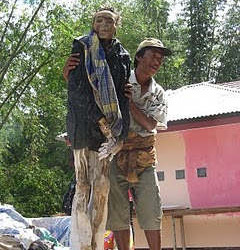

The Indonesian Walking Dead
Toradja people do practice something akin to the rising of the dead. It seems that the people believe that death is a long process, sometimes taking years as the deceased gradually work their way toward Puya (the afterlife). Very elaborate measures must be taken during the funeral to ensure that the loved one makes it safely to that destination.
Because the funeral arrangements are so extensive, they are also very expensive. For this reason, a body is sometimes placed in a temporary coffin. During this time, the family can accumulate the necessary funds to pay for a proper funeral, which includes a cave or hanging casket, a multi-water buffalo slaughter, chanting, singing, music, stone and wooden effigies to protect the soul during travel, and so on.
Once the funds are raised, so is the dead. It seems that the Toradja genuinely believe that the dead are able to walk themselves to their new burial site. More likely, and what we are seeing depicted in the picture, is that the somewhat mummified corpse is removed from its temporary coffin and transported upright to the permanent site. As “corpse walking” is part of the tradition, the body is held in the standing position to simulate ambulation.
They say the corpse is agreed using black magic. They do this because the cemeteries are in mountain regions, so no one wants to lead the deceased to the place they must walk alone.
The body follows, guided by an “expert” in black magic, which takes them to the site. However there is a rule, if called by name, the body falls and will not raise again.
#history culture#indonesia zombies#dead#death#rituals#black magic#magic#cemeteries#raising dead#indonesian walking dead#odditiesoflife#corpse#walking dead#history#culture#sociology
5K notes
·
View notes
Photo

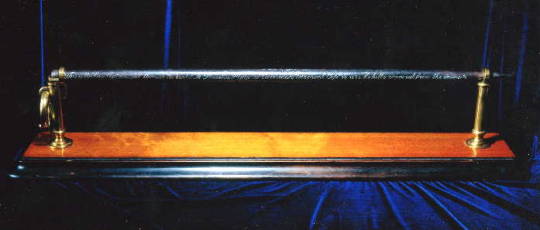
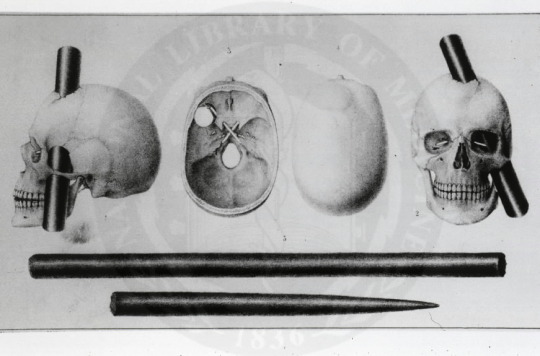
#history#phineas gage#vintage photos#science#medicine#psychology#warren museum exhibition gallery#boston#massachusetts#19th century#black and white photos#brain damage
3K notes
·
View notes
Photo



The Strange History and Mystery of the Ouija Board
Does the Ouija Board really communicate with spirits or is it just a harmless game?
The first advertisements started to appear in papers by 1891: “Ouija, the Wonderful Talking Board". The board was described as magical because it answered questions “about the past, present and future with marvelous accuracy”. It’s price was $1.50.
The Ouija board (pronounced Wee-ja) is a flat board marked with the letters of the alphabet, numbers 0-9, and the words “yes”, “no”, and “hello”, “goodbye”. The invention of the original design in still unknown.
The Ouija board was, at first, regarded as a harmless parlor game. It’s popularity grew out of the strong American 19th century obsession with spiritualism - the belief that the living are able to communicate with the dead.
The first patent was granted in 1891 to Elijah J. Bond as the inventor. Bond’s sister-in-law, Helen Peters (who was reportedly a “strong medium”), is credited for naming the board. While using the board, they asked what it should be named. The word “Ouija” was spelled out and when asked what that meant, the board replied, “Good Luck.”
To this day, mainstream religions and some occultists have associated the use of the Ouija board with the threat of demonic possession and have cautioned their followers not to use them.
Many believe that evil spirits, disguising themselves as deceased friends or family members, can trick the users of the board and unwittingly invite “them” into their homes. To be rid of such hauntings, Ouija “experts” advise either to burn the board or dispose of it in a lake since spirits supposedly cannot cross water.
source
#history#ouiji board#ghosts#spirits#spirit communication#divination#elijah bond#evil spirits#demons#pictures of ouiji boards#scary#paranormal
2K notes
·
View notes
Photo





Creepy Museum Exhibits
Because of the coronavirus pandemic, the Yorkshire Museum in England is having a weekly #curatorbattle on social media with other museums.These are just a few of the submissions that include taxidermy and mummifications. This is more the subject of nightmares. To see all the submitted items, click the “Creepy Museum Exhibits” title above this paragraph. Sweet dreams...
#museums#science#mummification#mermaids#taxidermy#yorkshire museum#london#scary#creepy#folklore#monkey#cats#creepy objects#unknown creature#odditiesoflife#vampires#curator battle
911 notes
·
View notes
Photo
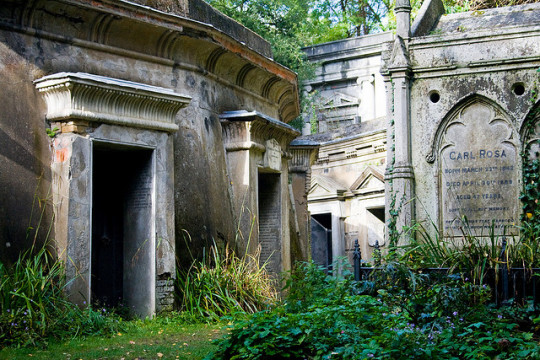

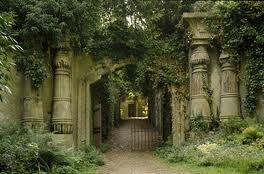



15K notes
·
View notes
Photo










10 Must See Photos from the 1950s
Marijuana plant in Van Nuys, California jail. Officer F.G. Plamonden gapes at blooming plant of marijuana. Officers wonder what goes on with the plant. Cops later found out that it was sent to Valley Division to be in a lecture on narcotics, 1951
Kicking it with the cool kids - photographer Jean Depara’s photos of life in Kinshasa, Africa in the early 1950s
Pablo Picasso has fun playing Popeye, 1957
Marilyn Monroe kicks a ball at Ebbets Field, New York, 1957
Miss New Zealand collapses during the Miss Universe pageant, 1954
Kisses and shiny new dimes given out to anyone who appeared “optimistic” in downtown Santa Monica during the Optimist Week celebration, 1951
A woman demonstrates shoes equipped with spurs and other sharp metal objects for fighting off men and their unwanted advances, 1956
Men in full make-up dining enjoying a meal together, 1950s
A rare look into Lucy and Dezi’s home in the 1950s
Taking a train ride on the real Orient Express as passengers eat in the dining car, 1950s
source 1, 2, 3, 4, 5
3K notes
·
View notes
Photo
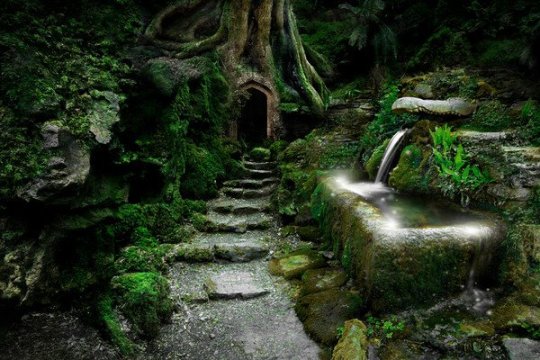
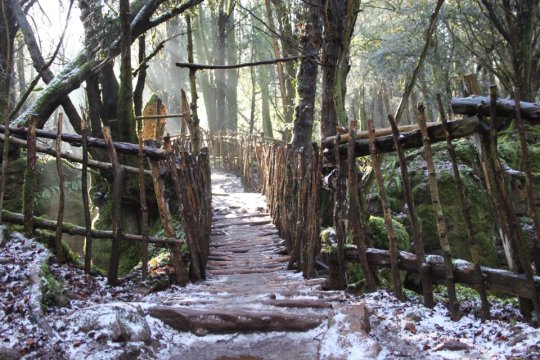

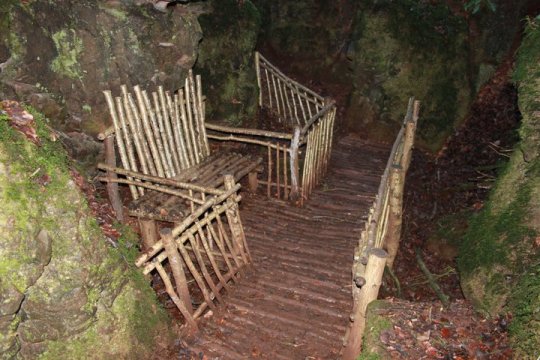






Puzzlewood Magical Forest – The Real Middle Earth
Puzzlewood is a unique and enchanting place, located in the beautiful and historic Forest of Dean in Gloucestershire, England. There is more than a mile of meandering pathways through Puzzlewood and over 14 acres of ancient woodland. It has an atmosphere quite unlike any other wood. The magical forest is one of the most stunning in the world and it’s easy to see why it’s been used as a filming location for Merlin and Dr. Who. It is no wonder that JRR Tolkien is reputed to have taken his inspiration for the fabled forests of Middle Earth from Puzzlewood.
In Puzzlewood you will find strange rock formations, secret caves and ancient trees. The geological features here are known locally as scowles. The scowles originated through the erosion of natural underground cave systems formed in limestone many millions of years ago. Uplift and erosion caused the cave system to become exposed at the surface. This was then exploited by Iron Age settlers through to Roman times for the extraction of iron ore.
Evidence of Roman occupation of the area is supported by the discovery of a hoard of over 3,000 Roman coins from the 3rd Century which were found in the scowles of Puzzlewood. Once the Romans left, nature reclaimed the old workings with moss and trees, to create the unique landscape. The historical use soon became forgotten, and the folklore of “Puzzlewood” began.
In the early 1800s, a local landowner laid down a mile of pathways which meandered through the trees and gulleys to open up this ancient forest originally for the amusement of his friends and children. In the early 1900s, Puzzlewood opened to the public. Since then it is has remained essentially unchanged with the same stunning pathways and bridges as in earlier times, but with the addition of a variety of animals and visitor facilities.
source 1, 2
88K notes
·
View notes
Photo




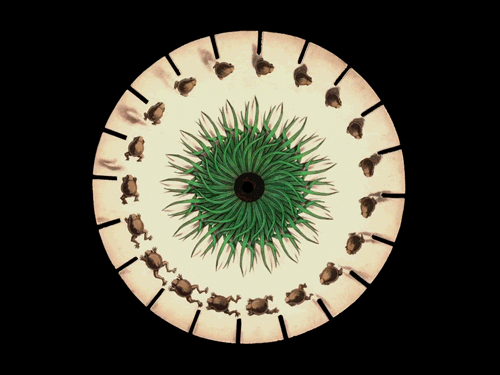
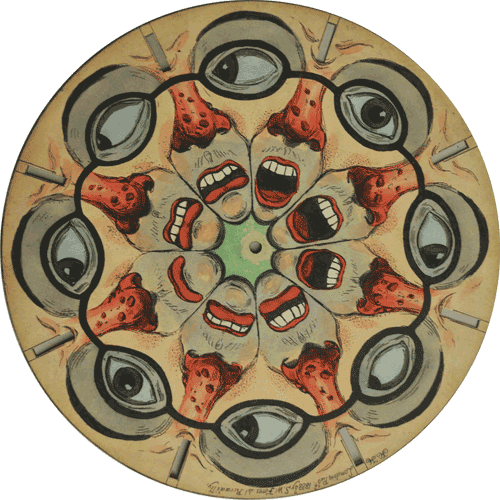
Incredible Vintage Animated Gifs
Nearly 155 years before the first animated gif appeared in 1887, Belgian physicist Joseph Plateau unveiled an invention called the phenakistoscope, a device that is largely considered to be the first mechanism for true animation. The simple gadget relied on the persistence of the vision principle to create the illusion of images in motion.
The phenakistoscope used a spinning disc attached vertically to a handle. Arrayed around the disc’s center were a series of drawings showing phases of the animation, and cut through it were a series of equally spaced radial slits. The user would spin the disc and look through the moving slits at the disc’s reflection in a mirror. The scanning of the slits across the reflected images kept them from simply blurring together, so that the user would see a rapid succession of images that appeared to be a single moving picture.
Though Plateau is credited with inventing the device, there were numerous other mathematicians and physicists who were working on similar ideas around the same time, and they too were building on the works of Greek mathematician Euclid and Sir Isaac Newton who had also identified the principles behind the phenakistoscope.
source 1, 2, 3, 4
10K notes
·
View notes
Photo






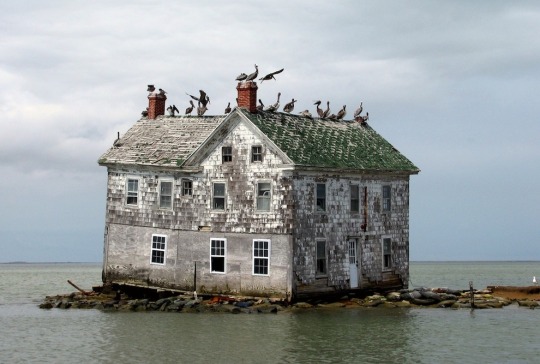
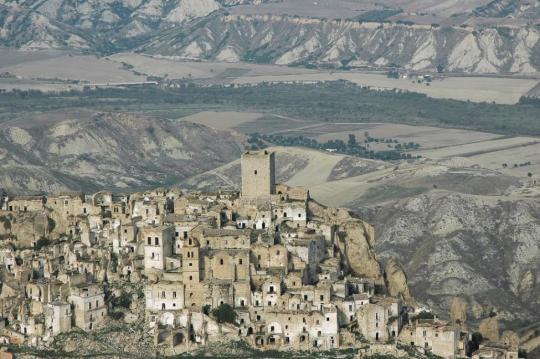

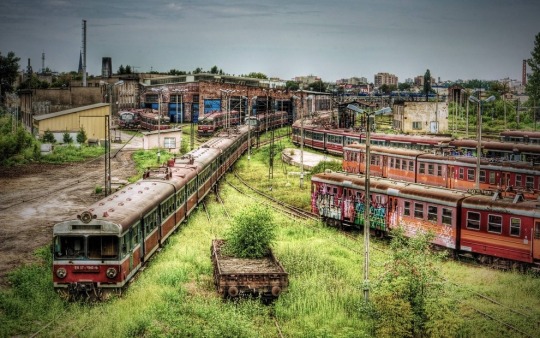
10 Amazing Abandoned Places Around the Globe
Spree Park, Berlin, Germany
Hotel del Salto in Colombia - featured previously on Curious History
Gulliver’s Travels Park, Kawaguchi, Japan
Abandoned mill in Sorrento, Italy
Mirny (Mir) Mine is a former open pit diamond mine located in Mirny, Eastern Siberia, Russia - The second largest man-made hole in the world
The abandoned flats in Keelung, Taiwan
Holland Island in the Chesapeake Bay, Maryland, United States
Craco is an abandoned commune and Medieval village in Italy
Dadipark Dadizel in Belgium
Abandoned train depot in Czestochowa, Poland
57K notes
·
View notes
Photo
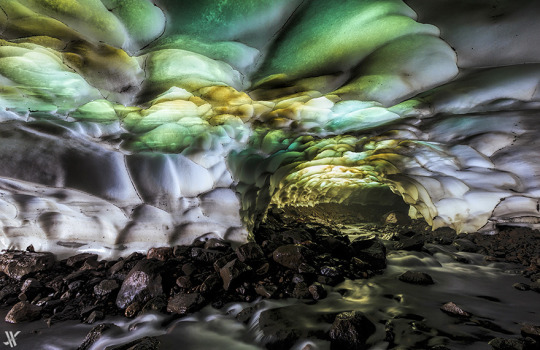

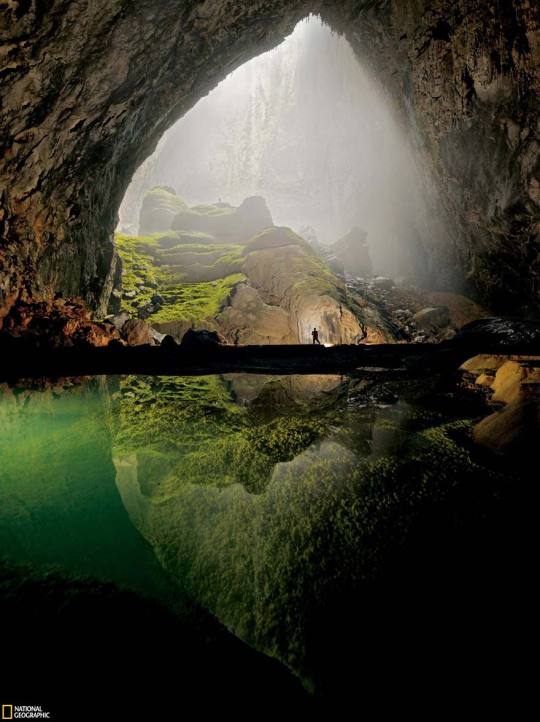
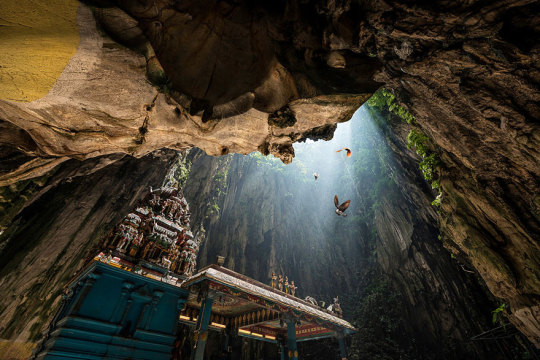
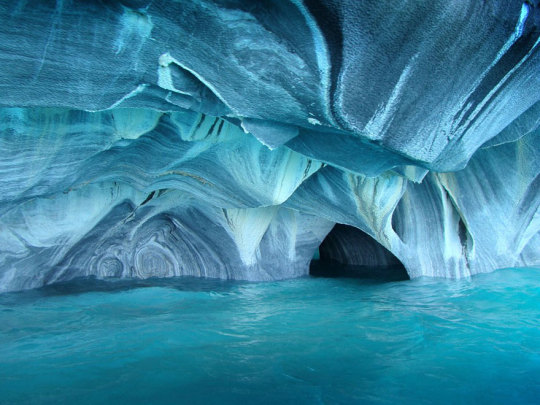
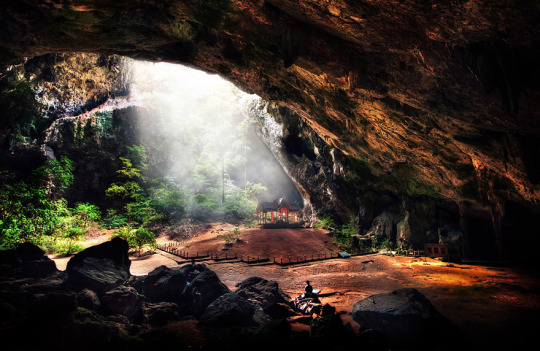



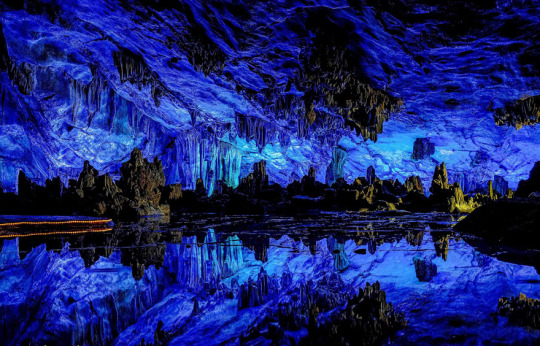
10 of the Most Majestic Caves in the World
Ice Cave Near The Mutnovsky Volcano, Russia - Ice caves like these form in the glaciers surrounding the Mutnovsky Volcano in Russia. Some of them are formed by vents that release volcanic heat and gases called fumaroles. (photo by Florian Wizorek)
Glowworms Cave, New Zealand - The Waitomo glowworm caves are home to a unique insect – the glowworm. These insects hang glistening silken strands from the ceiling of the cave and glow to attract unsuspecting prey. (photo by waitomo.com)
Son Doong Cave, Vietnam - This is the largest currently known cave in the world. It is filled with countless wonders including isolated ecosystems, weather systems and geological formations. (photo by National Geographic)
Batu Caves, Malaysia - These caves have been used by English and Chinese settlers as well as the indigenous Temuan people. The bat guano in the cave was mined for agricultural purposes, but now the cave is filled with statues and is open to visitors. (photo by Danny Xeero)
Marble Caves, Patagonia - Theses caves are known for the spectacular reflections that the turquoise water casts on the white marble ceiling of the cave. They are also called the Marble Cathedral because of their beautiful and arching forms. (photo by kellywhite)
Phraya Nakhon Cave, Thailand - This cave was historically a popular visiting place for local kings because of the illumination provided by the collapsed roofs. The pavilion in the center was built for the visit of King Chulalongkorn in 1890. (photo by Wasitpol Unchanakorrakit)
Ellison’s Cave, United States - This photograph is of the Fantastic Cave pit, part of Ellison’s Cave in the state of Georgia. It is a popular attraction for pit cavers – those who enjoy rappelling down vertical subterranean drops. (photo by secondglobe.com)
Vatnajokull Glacier Cave, Iceland - This cave is located in the largest glacier in Europe. Caves like these form due to melting glacial icewater, but they can be dangerous because glaciers are constantly breaking and changing. (photo by Einar Runar Sigurdson)
Cave in Algarve, Portugal - Due to its location, the cave is prone to various seaside formations because of the rock face’s relative solubility in water. This specific cave near Lagos is accessible only by water. (photo by Bruno Carlos)
Reed Flute Cave, China - The Reed Flute Cave in Guangxi, China has been visited by tourists for at least 1200 years. The cave is home to a spectacular array of stalagmites and stalactites. It is named for the reeds that grow at its mouth, which can be made into flutes. (photo by Pasquale di Pilato)
50K notes
·
View notes
Photo
Oddities of Life is BACK!!! Follow Me into the Odd.....




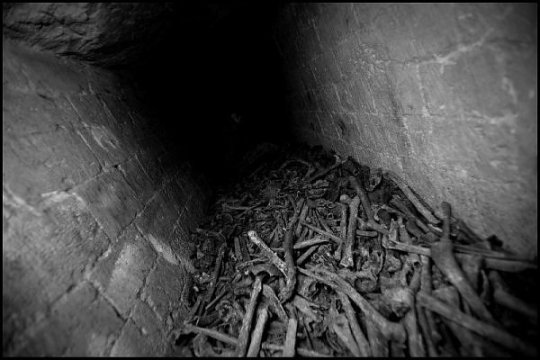

Paris Catacombs
By the light of torches, candles or miners lights, haunting scenes centuries old appear to unfold. Scenes of skulls, bones and death are everywhere. The passages can be as low as three feet overhead or even less. The air heavy with dust, and the ground underfoot flooded with grimy water splashing way over your shoes. In tunnels up to 100 feet below the surface bustle of one of the world’s great cities, another clandestine world exists.
Consulting maps, self-trained guides lead the way, while others look for opportunities to take photographs. Exploring the Paris Catacombs, also known as the Mines of Paris, carries risk. For one, it is strictly illegal, with special police and their dogs patrolling the vast subterranean network. There is also a very real danger of getting lost, as well as the chance of cave-ins in some places.
5K notes
·
View notes
Photo
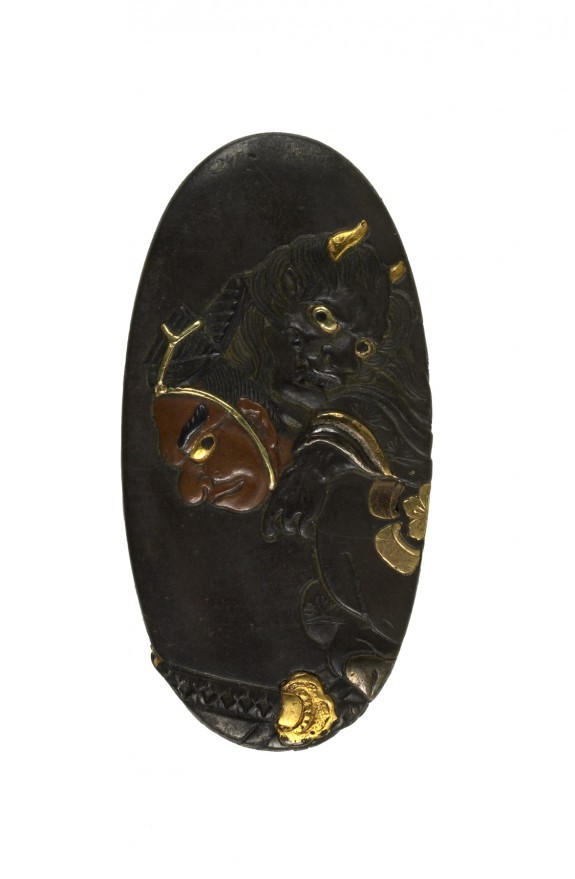
Got a Demon on Your Back?
Ômori Hikohichi, a 14th-century warrior, is shown with a female demon on his back. Hikohiki is said to have offered to carry a beautiful woman across a stream. While crossing the stream, he saw her reflection as a demon in the water. In some versions of the story he kills her, while in others she runs away. When the story was adapted for use in theatrical dramas, the woman was portrayed as the daughter of Kusunoki no Masahige, who erroneously thought Hikohichi was responsible for her father's death. The daughter was not actually a demon, but wore a mask to frighten Hikohichi.
#history#vintage#art#engraved#wood carving#inlay#gold inlay#engraving#demon#omori hikohichi#14th century#japanese warrior#female demon#katsunaga#shibuichi#copper#gold#myths#japanese mythology#japan
66 notes
·
View notes
Photo

The Most Photographed Stone East of the Mississippi
Very near the Soudan Underground State Park administered by the Minnesota Department of Natural Resources is what some people call "the most photographed outcrop in the state." This is a pavement outcrop of folded banded iron formation. The outcrop consists of metallic hematite, red jasper and white chert. These originally horizontal layers have been folded multiple times. In some areas, the jasper and chert have fractures filled with milky quartz.
#science#geology#minerals#soudan underground state park#mississippi#strange rock formations#amazing stones strange things
8K notes
·
View notes
Photo





It's an Odd & Small World After All
In its 40th year, Nikon Small World is one of the leading forums for recognizing excellent microscopic photography. Subjects above cover biological specimens.
1) Jumping Spider Eyes Reflected Light - 20X
Noah Fram-Schwartz; Greenwich, Connecticut, USA
2) Bed Bug (Cimex lectularius) - 50X
Mr. Stefano Barone; Cremona, Italy
3) Developing Mouse Embryo Eye - 20X
Ms. Zsófia László; Budapest, Hungary
4) Ant Eye Reflected Light - 20X
Noah Fram-Schwartz; Greenwich, Connecticut, USA
5) Underside of the Brown Dog and Lonestar Tick Mouthparts - 100X
Dr. Igor Robert Siwanowicz; Ashburn, Virginia, USA
source
1K notes
·
View notes
Photo

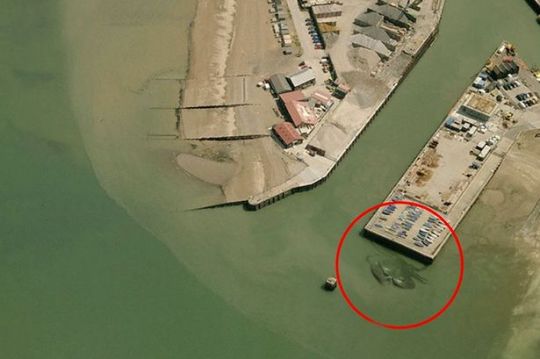
Crabzilla or Hoax?
Is this a freakishly huge crab or just someone bored playing with photoshop? You might have seen this image within the last few days. The above photographs of Whistable harbour led people to believe that a monster-size crab (nick-named "crabzilla") is living off the Kent coast in the United Kingdom.
Residents of Whitstable were stunned when the picture appeared to show a huge crab at the base of the coastal town's harbour.
However a marine biologist, Dr. Verity Nye, who is an ocean and earth science researcher at the University of Southampton states: "The idea of a giant "crabzilla" would very exciting. Unfortunately, I think this is a hoax."
She further stated that the United Kingdom does have large crabs but not anywhere near this size. The largest crabs tend to stay in deeper water and that this particular image is a different shape than previously identified huge crustaceans.
But this is just one scientist's opinion...anything is in the realm of possibility when it comes to ocean life. Hundreds, if not thousands, of new species of marine life are discovered every year. Perhaps he'll make another appearance...
source
832 notes
·
View notes
Photo

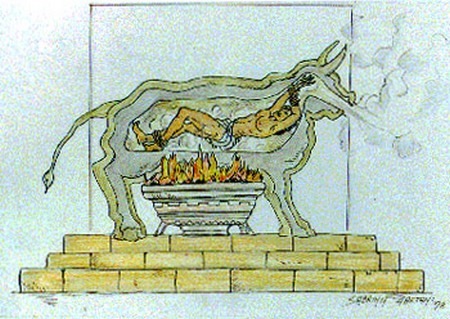

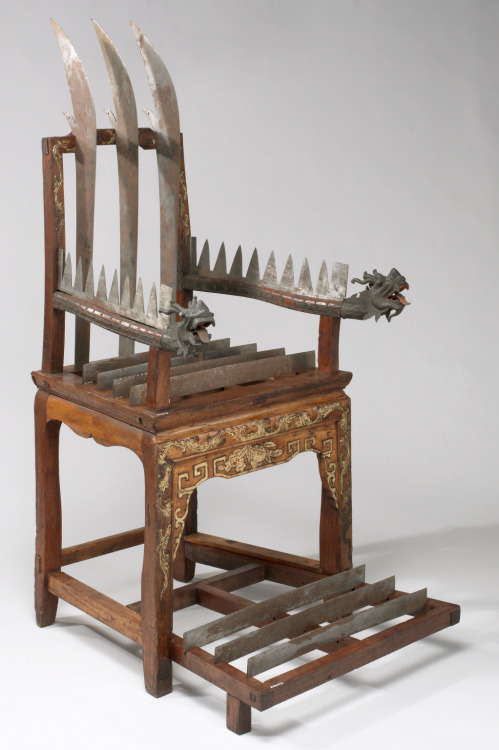


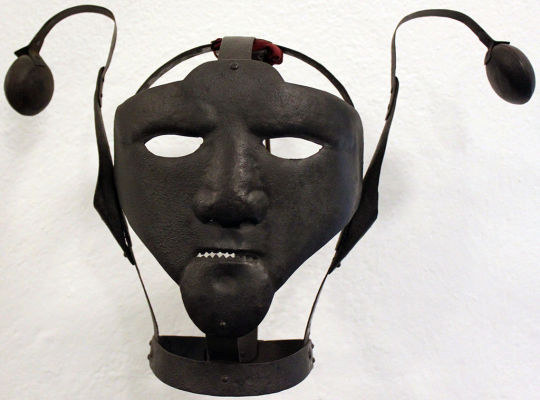
Horrific Torture Devices Throughout History
The Rack - Probably the most infamous and widely used instrument of torture was the rack which dates back to the ancient Greeks. There are few records of its use before the Middle Ages but, during the Spanish Inquisition, there was a large increase in its use.
The Brazen Bull - This device was designed in Greece by Perillos of Athens. He was a brass founder and cast the shape of a hollow bull with a door on the side. The condemned person was put inside the bull and a fire was lit underneath the device causing the person to roast to death. It was configured with tubes and pipes so the person screaming inside would sound like the bull was raging.
Amputation - Even minor crimes in Medieval Europe could send the offenders to the executioner. Varies body parts were amputated or mutilated in lieu of death, although most victims would die from complications from the "procedure". No body part was off limits.
Wooden Torture Chair with Steel Blades - Mainly used in China, this chair was a severe form of punishment. Despite its horrific use, these chairs were often ornately decorated with foliage, scrolls and the heads of mythical sea monsters called Macara.
The Breaking Wheel - This wheel of torture was used to kill criminals in an extremely slow and painful way. This device was a large wagon wheel. People were chained to the wheel at their wrists and ankles. They were then beaten with hammers and stuck with hot pokers. After the torture was complete, prisoners were left attached to the wheel while birds would peck at their flesh until death occurred.
Punishment of the Wooden Collar - It is composed of two pieces of wood, hollowed out in the middle, which, when put together, leave room for the neck. The weight of the collar ranged from 40 to 200 pounds depending on the severity of the crime. Immobility and public
Scold's Bridle (also known as branks) - A 16th century instrument of punishment used primarily on women. The device was an iron muzzle that enclosed the head with a bridle-bit projected into the mouth and pressed on top of the tongue. The curb-plate was often studded with spikes so if the offender moved her tongue, the pain would be unbearable making speech impossible. Women seen as shrews, nags and even witches were often forced to wear the bridle.
sources 1, 2, 3, 4, 5, 6
2K notes
·
View notes
Photo
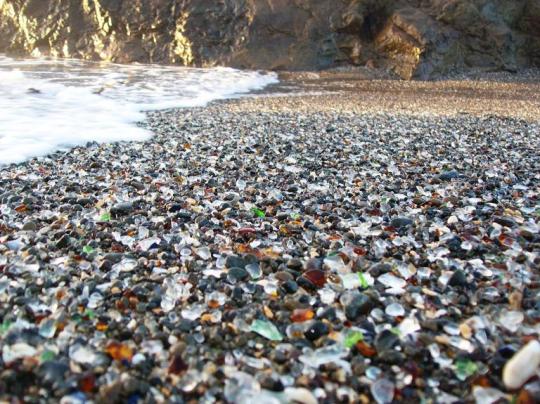




Five Fascinating Beaches Around the World
Glass Beach - Fort Bragg, California
Fort Bragg residents used to throw their garbage (including glass bottles) over a cliff onto the beach before it was outlawed in 1967. Over the decades the waves and sand have broken down the glass into smooth, rounded pieces.
(Photo: mlhradio/Flickr)
Jokulsarlon Lake - Iceland
The glacial lake is located in the Vatnajokull National Park, and the shore is filled with huge pieces of ice resting on black volcanic sand. But what really makes this beach unique is that during the winter, it is the perfect place to see the breathtaking northern lights.
(Photo: Ingo Meironke/Flickr)
Bowling Ball Beach - Schooner Gulch, California
The rocks at the Schooner Gulch State Beach are almost perfectly round due to a natural process called concretion.
(Photo: John K/Flickr)
Shell Beach - Shark Bay, Australia
This beach is home to billions of coquina bivalve shells instead of fine grains of sand. The water has a high salt concentration that attracts the shelled creatures.
(Photo: Stefan L/Flickr)
Maldives Beach - Republic of the Maldives
This beach in the Maldives lights up at night, thanks to microscopic organisms called bioluminescent phytoplankton. The organisms respond to changes in the water. Any movement will leave an impressive trail of bluish lights.
(Photo: Exilism/Flickr)
source
5K notes
·
View notes